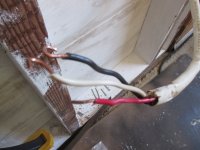- Location
- San Francisco Bay Area, CA, USA
- Occupation
- Electrical Engineer
I'm in a discussion on the issue of whether people ever used 10/2 W/G as a feed for a 240V circuit that needed a Neutral. Someone is arguing that it was allowed until 1996 and that lots of dryers were wired with 10/2-w/G. I got my license in 1978 and at that time, Neutral was considered a "current carrying conductor" and had to be insulated. That 10/2-w/G may be true, because on a 10-30R the bent prong is the GROUND, not a neutral and although the neutral (if any) inside of the dryer was often bonded to the Ground to be able to power the time clock, technically the bare copper wire in the cable feeding this was not really considered a "neutral" conductor. Am I wrong?

